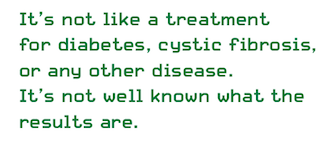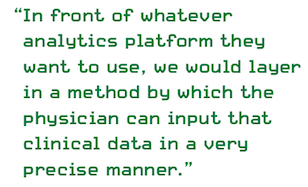Fighting Cancer with CAR T and Big Data
As therapies like Kymriah and Yescarta transform medicine, how can hospitals take advantage of analytics to improve processes and patient outcomes?

John Cunningham stood at the edge of tomorrow. The pediatrics chair of the University of Chicago Medicine and physician-in-chief at its Comer Children’s Hospital had just heard from Novartis. The Swiss drugmaker was assembling a group of premier medical centers to use a new treatment for certain blood cancers. It was tisagenlecleucel, or Kymriah, a highly anticipated chimeric antigen receptor (CAR) T-cell therapy that alters an individual’s genes to destroy malignant cells.
His team had already administered CAR T therapies in clinical trials. So, Cunningham, also the director of hematopoietic stem cell transplantation, signed on. His joint adult-pediatric program treated about 15 people with the immunotherapy before it was licensed. “I beat the odds,” one patient later told the hospital. “Now we’re talking about a cure.” Broadly, the agent proved successful in more than 80% of trial participants, but it sometimes caused serious adverse effects (AEs).
In late August, Kymriah gained approval from the FDA for use in patients with refractory or relapsed B-cell acute lymphoblastic leukemia younger than 25 years old. It became the nation’s first gene-modified therapy to get the green light. That same day, University of Chicago Medicine announced that it had been certified to deliver the “breakthrough” therapy.
It took considerable effort to get there. After Novartis came knocking, Cunningham and his colleagues began developing processes to deliver the treatment. Much of their work focused on the mechanics of the therapy itself—it required cell harvesting, good tissue practices, and transportation logistics, to name a few.
But they also turned toward data. They tweaked their electronic medical records (EMRs) system and mobilized information. “We’ve developed algorithms so it’s done in a reproducible manner every single time,” Cunningham told Inside Digital Health™.
Going forward, hospitals and other healthcare organizations working in the universe of CAR T therapies like Kymriah should harness the power of data, analytics, and artificial intelligence (AI), according to experts interviewed for this story. New information technologies could improve outcomes, further value-based care, and help revolutionize the fight against cancer.
CAR T on the Rise
CAR T-cell therapies are set to become big business. Five years ago, only a few were in clinical trials, according to the National Cancer Institute. By the end of this summer, that number had blossomed to more than 180. And in mid-October, the FDA sanctioned a second cell-based gene therapy: Kite Pharma’s Yescarta, for patients with specific lymphomas. Meanwhile, 3 budding treatments, including Kymriah, are collectively projected to earn close to $3 billion by 2023, according to consensus sales forecasts.
The bottom line: More hospitals—and their administrators and information technology and informatics departments—must prepare for CAR T therapies, experts told HCA.
That push should include building out data and analytics infrastructure, experts said. Crunching the numbers helps hospitals decide not only whether they ought to pursue these therapies but also who performs them, how to improve quality, and their value. What’s more, since CAR T is in its early days, each data collector may contribute to a body of knowledge hungry for more information, experts said. But where to start?
Determining Where CAR T Fits
Before University of Chicago Medicine decided to add Kymriah to its toolkit, hospital employees went through the business planning stage. They analyzed the demands of, and demand for, the treatment. They checked the boxes—laboratory and monitoring capabilities, among others—and then committed. “It’s really important to really think about whether you have all the resources necessary to do this,” Cunningham said. “I think it will still be major academic centers, at least in the short term, who have the kind of informatics and cellular therapeutics, who will be the main purveyors of this kind of therapy.”
The 2 CAR T-cell therapies approved thus far have a limited market cap. Novartis has announced plans to tap only 32 medical centers to use Kymriah, which Novartis developed in partnership with the University of Pennsylvania. As the FDA marks these treatments and coming ones for use against more diseases, that might change, experts have said. Although some key opinion leaders believe CAR T will move into smaller hospitals quickly, few question the barrier posed by its intricacies and novelty.
CAR T therapy requires blood to be drawn from a patient, and then the T cells are isolated and genetically modified in a lab so that their surfaces carry CARs. That allows the T cells to identify and attach to certain antigens in tumor cells. Scientists then reproduce the engineered T cells so that they number in the hundreds of millions. Afterward, the cells are shipped back to the hospital—in Kymriah’s case, from a Novartis facility in New Jersey—and infused into the patient. There they may multiply and kill cancerous cells.

Long before, however, hospitals must consider the populations they serve and future payer arrangements. Have they taken on Medicare, Medicaid, and fee-for-service, and how might the dynamic change? “My becoming an early adopter,” Jean Drouin, MD, MBA, and CEO and cofounder of the analytics- and value-driven company Clarify Health Solutions, said, referencing hospitals, “is going to be highly, highly driven by, ‘In that tiering of different payer arrangements, is there a large enough pool that they’re eligible for it, and does it make sense for me to be able to go in and provide the service?’” If the data and population health studies bear that out, it could indeed make sense. The same is true if a clinical trial covers the cost of the treatment, or the institution is willing to lose money in exchange for offering the most cutting-edge treatments, he said.
Gathering and Taking Advantage of Data
When Cunningham’s unit in Chicago moved to roll out Kymriah, he said it had a big plus: a “phenomenal” informatics program. Further, the institution’s center for information systems helped modify and develop data processes. Those internal resources enabled them to forgoe hiring additional data staffers, a step that other hospitals might need to take. The hospital also worked with Novartis to launch the program.
Medical center employees refashioned the EMR system, ensuring that it could capture all the necessary data flowing from Kymriah treatments, Cunningham said. His squad uses Epic, and they customized it to be able to transmit information into electronic databases. In the months ahead, they expect to develop new tools.
Strengthening the EMR was critical because the FDA, unlike after many other clinical approvals, asked the hospital to collect a “significant amount of data” on patients, he said. Regulators hoped to compile this information to better understand long-term outcomes and AEs. After all, fewer than 200 patients had undergone treatment by the middle of last month, Cunningham noted. “It’s not like a treatment for diabetes, cystic fibrosis, or any other disease,” he said. “It’s not well known what the results are.”
The possible AEs of CAR T-cell therapies are severe. Patients are at risk of delirium, B-cell aplasia, cerebral edema, and cytokine release syndrome. The so-called cytokine storm actually shows that altered T cells are doing their job, but it can lead to dangerous fevers, blood pressure drops, and respiratory distress syndrome. To combat these effects, hospitals need properly trained providers and resources, along with a related drug approved alongside Kymriah.
But analytics can help tackle such problems early on. Andre Goy, MD, chairman and director of the John Theurer Cancer Center at Hackensack University Medical Center, resolved to do just that. His New Jersey—based hospital, which is opening a CAR T unit, has written an algorithm that is capable of detecting and tracking cytokine release syndrome. That empowers his staff to “monitor very carefully the neurological statuses of these patients so we can intervene early on, based on the grade that we have in the algorithm to trigger the supportive care that is required,” he said in an interview with HCA.
Predictive analytics, meanwhile, can spotlight issues before they even crop up in individual patients. By combining information from large public or shared data sets with personal histories and clinician insights, hospitals can determine who will face AEs and what kinds, Drouin said. Experts noted that the data set is relatively small for CAR T-cell therapies, given the small pool from which investigators can draw information. But, they said, this tool could become more powerful, as it has in other corners of healthcare, if medical centers prioritize data collection.
Equally important is installing standards that will yield high-quality data, experts said. For this, it’s vital that clinicians and healthcare organizations working with CAR T get on the same page. Jay Anders, MD, a big data and AI veteran and chief medical officer of the EMR firm Medicomp Systems, said the field has no common data language or interface to permit reliable communication. Developing such benchmarks is the first step to reaping good data from the small population, he said.
Hospitals must also train clinicians—the “most powerful computer in the room”—to input useful, accurate data, he added. Conversely, institutions should solicit comments from the same clinicians to recognize which data points might be most practical in bolstering care and, thus, outcomes, he said.
“In front of whatever analytics platform they want to use,” Anders went on, “we would layer in a method by which the physician can input that clinical data in a very precise manner so that the platform underneath is getting very clean and very accurate data, so it can do its magic and feed that back to the physician.” Because, in the end, any data gleaned from hospitals are maximized when clinicians can apply the information to benefit a single patient, Anders said.
Along the way, pharma companies have forged partnerships with analytics firms to ensure the safe and effective delivery of CAR T-cell therapies on a commercial scale. Kite Pharma, for instance, joined forces late last year with Vitruvian Networks to develop software to enable ordering, tracking, and more.
Increasing Value
The price of a single Kymriah treatment, which patients are meant to receive only once, runs $475,000. That cost is either exorbitant or a bargain, depending on who’s talking. Novartis has claimed it could have chosen a much higher price point, but patient advocate groups have argued that such a significant therapy, which took public research dollars, should cost less. For now, the pharma giant has decreed that it will charge payers only in cases when Kymriah yields positive effects within a month.
The University of Chicago’s medical school has yet to home in on ways to gauge and improve the value of Kymriah. Cunningham and his team are just wrapping up clinical trials, and their primary concern has been the efficacy of the therapy, not how its effectiveness and cost measure its value. “Now is the time to think about that,” he said.
In fact, experts said, value is the area where data, analytics, and AI hold the most promise for CAR T-cell therapies. Clarify Health Solutions’ Drouin reasoned that the same approaches used to match patients with medical facilities and drugs can translate to CAR T, creating road maps “in order to heal them as fast as possible but for the lowest cost,” advancing value.
To do this, institutions can use EHR and other data to analyze metrics like total cost, readmission rates, and more, to compare providers to their peers. As data sets expand, institutions will need to establish granular, dependable data to distill precise insights, Drouin said. From there, they must pump out data visualizations that are captivating enough to send clinicians and other professionals into action. By implementing such a system on a large-scale basis, healthcare systems can cut unnecessary spending by millions of dollars or more, he said.

In the case of Kymriah, value might be of most concern to payers and the pharma company, Drouin said. The high ticket price could worry payers, but if analytics show the therapy works, they will be more eager to stomach it. Novartis, then, has already deemed its treatment to have ample impact to justify a pay-per-outcome model, Drouin noted.
“I think the big data is going to be used more around, ‘Should this be paid for?’ And, if so, what’s the maximum that the payer is willing to pay? We’re not quite there in the world of reimbursement,” he said. “But we’re going to get there really, really quickly.”
Filling in the Blanks
As CAR T-cell therapies like Kymriah leap out of clinical trials, the need to accumulate data grows. As Peter Gabriel, MD, the head of informatics at the University of Pennsylvania’s Abramson Cancer Center, recently noted, roughly 97% of the population is not represented in test runs. That means the research cannot be generalized.
This is especially significant for CAR T because almost nothing is certain regarding long-term effects of the treatment, the University of Chicago’s Cunningham said. Investigators have fewer than 10 years’ worth of information, he said. Although outcomes a year after treatment indicate success, he added, medical centers must continue to pin down the facts and minimize risk.
“There are many, many other malignancies that might benefit from CAR T,” Cunningham added. And if hospitals, investigators, and companies take building data infrastructure seriously, they just might identify those targets sooner than later.